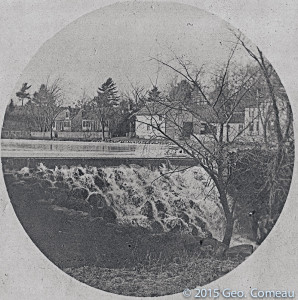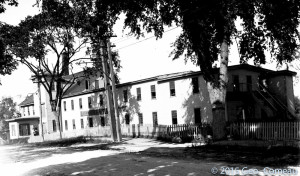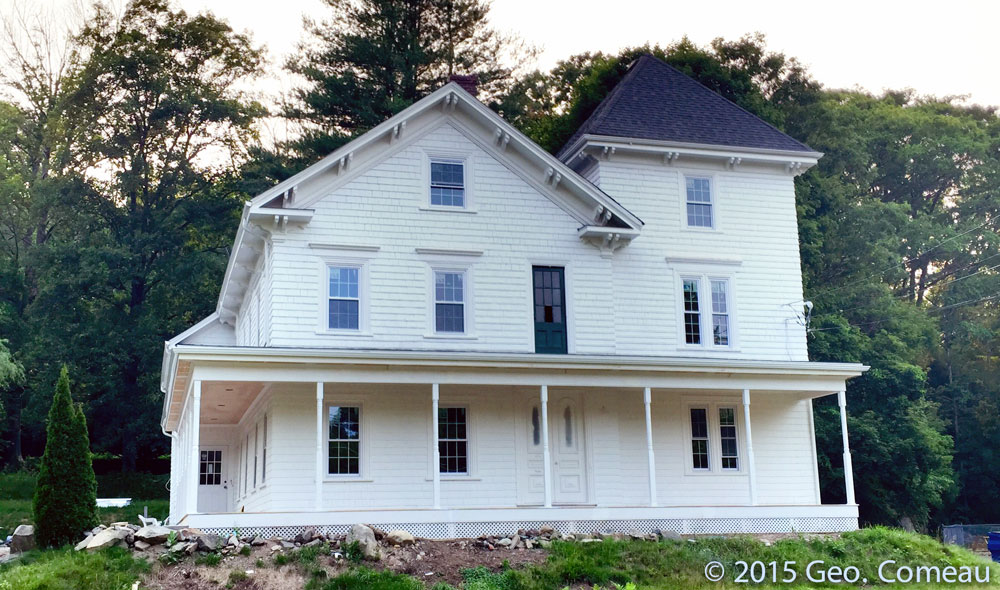True Tales: Net Proceeds
By George T. ComeauWhen a real estate sign goes up in front of an old historic estate house, local historians shudder at the thought of a developer buying the property simply to tear the house down to build new multi-family units or condominiums. It has happened many times in Canton, and each time there is a quiet outcry; a few comments are made along the lines of “we should have saved that house,” and then nothing changes.
Over the next few weeks, as you drive down Sherman Street just after the library, watch the hill on your right. At the top of the hill sits the suburban estate house at 479 Sherman Street, which was built sometime between 1869 and 1876 for Albert B. Chase. This house was remodeled for George H. Capen after 1910 and converted to a multi-family apartment building in 1945. Peaking out from behind the siding you can see that this was once a grand old house. The design was originally Italianate Style as seen in the projecting low hip roof and dentil molding under the eaves. The interior hallway retains the original octagon Italianate newel post and paneled doors. The entrance door was remodeled after 1910 in Georgian Revival Style with leaded glass sidelights and a fanlight transom. The Chase-Capen House retains its imposing silhouette on Sherman Street as a mid-19th century estate, and soon it will be gone. It will be replaced by townhouses as progress and development continue to take a toll on Canton’s history.
The equation is simple. Land values and multi-family homes are driving Canton’s population higher as developers seek to gain the highest and best use of raw property. Removing historic assets is one solution, yet for others adaptive reuse is becoming a second route. Take, for instance, the proposed condominium development at the Rising Sun Stove Polish Factory on Washington Street. The plan calls for adapting the old mill building, with the hope that the developers appreciate the true architectural and historical details such that we can still retain our history while moving forward with a profitable project for all concerned.
So it was with trepidation and more than a tremble when the “for sale” sign went up on the large white house on Washington Street next to the Gridley School. The house is an unmistakable gem in what should become Canton’s next historic district. This is the James Stratton Shepard House, and in its day it was simply an amazing landmark. When the real estate sign went up, the house was in very tough condition. In late November of last year the listing read, “Contractors take notice. Here is an opportunity to restore this beautiful Victorian. Keep it as a two-family or bring it back to its glory days as a single-family home. As you walk through this house, you will see the character and charm that lie underneath years of use.” And within 30 days the house was sold for $399,000. Today, the house is being extensively renovated and will soon again be the jewel in the Hardware District of Canton.
The house has an amazing and wonderful history. The land on which it was built was set off when Walter Lord sold the parcel of three acres to Shepard, who had come to Canton to build his empire. The house was likely built around 1855 and became one of our more important residences through its history.
James S. Shepard was the son of Joseph and Mary (Stratton) Shepard of Foxboro. Born to a poor family, James went to work in a cotton mill at age 10 and worked there until he was 15. In 1832, he began learning the machinists trade in the mill of George H. Mann in Sharon. Over the course of seven years, he rose to prominence and became the mill manager. In 1839, he formed a partnership with his brother Joseph in the manufacture of straw goods. The partnership with his brother soured and Shepard went back to managing the mill in Sharon.
Business boomed in New England in the early 1840s, and Shepard quickly began to amass wealth. At age 24 he married Mary Belcher from Canton, and the couple lived in Sharon for a short time and began building a family. All the while, Shepard was managing ever-larger mills and building up a substantial savings. When Mann’s mill burned in 1839, Shepard began making palm leaf hats. By 1844, he had saved enough money to move to Canton and build a house as well as buy a mill of his own. Life in Canton would be fulfilling and lead to great things for the poor boy from Foxboro.

A view of “The Falls” taken in the 1860s and demolished late last year (Courtesy of the Canton Historical Society)
If you looked closely at the sides of the dam on Washington Street when it was demolished last year, you would have seen the vestiges of a nearly 300-year-old mill privilege. The waterway on Shepard’s Pond as it passed under Washington Street was first developed in 1717 by nine men. Dorchester’s earliest industrialists, each owned a part of the iron works known as the London New. The dam, which the town recently destroyed as part of a million-dollar upgrade, was one of the most historic and sensitive sites in Canton. We have a long and sullied habit of tearing down our history and replacing it with a sign in the name of progress.
That diminutive site on that beautiful waterfall was also the location of a gristmill, and between 1772 and 1809 the site of Richard Gridley’s iron forge. This was a place where at various times swords, sleigh-shoes, ploughshares, and horseshoes were forged. William and John Danforth made iron candlesticks here. By the 1830s the site became used as a cotton manufactory for William Jencks, who made candlewicks. When Shepard moved to Canton in 1844, a small mill for thread-making owned by Jedediah and Ashael Southworth occupied a space across from another mill owned by Vernon A. Messinger. These would become the mills upon which Shepard would build his empire.
The story goes that one day, Shepard was in Boston and a fisherman by the name of McCarthy was buying fishing supplies and expressed an opinion that “somebody in this country might turn an honest penny by getting up a twine especially designed for nets, and better than the imported hemp twine then used.” Shepard returned to his fledgling mills in Canton and began making cotton twine, which he gave to McCarthy, who in turn made it into gill nets. The cotton was an improvement, and Shepard went on to further advance the product such that his cotton twine became the basis for an entire new industry of gill net and seine fishing.
In 1856, Shepard sold his interests to Martin Wales, who had founded the Stoughton Branch Railroad Company. The sale coincided with the construction of his large estate house on Washington Street. Shepard’s fortune soared to the point that in 1864 he became a partner in the American Net and Twine Company of Boston and leased his own real estate back to the company.
After the Civil War, Shepard became actively engaged in the manufacture of fish nets and seines, as well as twines. He was also the largest shareholder in the American Net & Twine Company, and with his family held a controlling interest. The nets made in Canton were the first in America to be made by machinery. The industry assumed such proportions that a large manufacturing plant was erected in East Cambridge in 1879. Fishing nets and seine made in Canton revolutionized the fishing industry and were used from Labrador to Alaska as well as in Europe. More than 40 workers were employed at the Canton factory.

The American Net and Twine Company once stood on Washington Street near Shepard’s Pond. (Courtesy of the Canton Historical Society)
Upon receiving the highest award at the Centennial World’s Fair in Philadelphia in 1876, the “Shepard Twine” assumed the name of “Shepard Gold Medal,” which became standard throughout the country. The twine went on to receive the highest awards at the different international expositions in Chicago, London, Paris, and wherever else it was exhibited.
In 1896, in order to be nearer to the cotton supply and to facilitate the manufacturing of the twine, the plant was relocated from Canton to Anniston, Alabama. A modern and extensive mill was erected there for the exclusive manufacture of seine twines, which were produced in much larger quantities than before to meet the increasing demands. Around the plant a town was developed, with churches, schools, etc., so that it became the model factory town of the south.
One of the more fascinating parts of the story is the fact that Shepard’s 21-year-old daughter, Sarah, married Ivers Adams from Ashburnham, Massachusetts. The wedding took place in Canton, and likely at her home on Washington Street. As the first president of the Boston Baseball Association in 1871, Ivers Adams was the father of professional baseball in Boston. The association’s baseball team was a charter member of the National Association during its inaugural season in 1871, played five seasons in that league, and then became the Braves franchise in the National League.
Shepard was our state representative in 1871 and was a director of the Neponset National Bank. When he died in 1898 the newspaper headline proclaimed, “A long and useful life ended.” The house is a reminder of Canton’s place in the world and our link to more than 300 years of industry. Fortunately, this house was saved from the wreckers and remains a site of national importance for all to see and appreciate.
Short URL: https://www.thecantoncitizen.com/?p=30145











